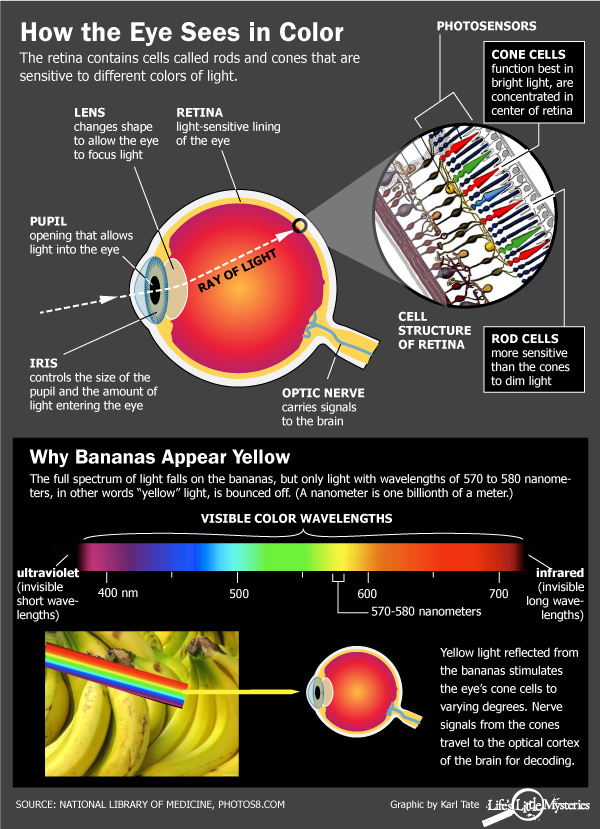How do we see color?
It's thanks to specialized receptors in our eyes.
Roses are red and violets are blue, but we only know that thanks to specialized cells in our eyes called cones.
When light hits an object — say, a banana — the object absorbs some of the light and reflects the rest of it. Which wavelengths are reflected or absorbed depends on the properties of the object.
For a ripe banana, wavelengths of about 570 to 580 nanometers bounce back. These are the wavelengths of yellow light.
When you look at a banana, the wavelengths of reflected light determine what color you see. The light waves reflect off the banana's peel and hit the light-sensitive retina at the back of your eye. That's where cones come in.
Related: How do our eyes move in perfect synchrony?
Cones are one type of photoreceptor, the tiny cells in the retina that respond to light. Most of us have 6 to 7 million cones, and almost all of them are concentrated on a 0.3 millimeter spot on the retina called the fovea centralis.
Not all of these cones are alike. About 64 percent of them respond most strongly to red light, while about a third are set off the most by green light. Another 2% respond strongest to blue light.
Get the world’s most fascinating discoveries delivered straight to your inbox.
When light from the banana hits the cones, it stimulates them to varying degrees. The resulting signal is zapped along the optic nerve to the visual cortex of the brain, which processes the information and returns with a color: yellow.
Humans, with our three cone types, are better at discerning color than most mammals, but plenty of animals beat us out in the color vision department. Many birds and fish have four types of cones, enabling them to see ultraviolet light, or light with wavelengths shorter than what the human eye can perceive.
Some insects can also see in ultraviolet, which may help them see patterns on flowers that are completely invisible to us. To a bumblebee, those roses may not be so red after all.
Originally published on Live Science.

Stephanie Pappas is a contributing writer for Live Science, covering topics ranging from geoscience to archaeology to the human brain and behavior. She was previously a senior writer for Live Science but is now a freelancer based in Denver, Colorado, and regularly contributes to Scientific American and The Monitor, the monthly magazine of the American Psychological Association. Stephanie received a bachelor's degree in psychology from the University of South Carolina and a graduate certificate in science communication from the University of California, Santa Cruz.




